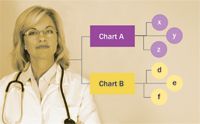e-Marketing at the Tipping Point
Pharmaceutical Executive
In 2004, US growth hormone sales reached nearly $711 million. But harsh restrictions on growth hormone treatments and their abuse as "lifestyle drugs" have injected controversy into the market. How can pharma ensure that its marketing efforts for products that help millions of children and adults reach the right targets?
Internet Marketing Expert Seth Godin Believes that companies should "date their customers" to solidify business relationships. He paints a picture of marketers treating customers like a date—striking up conversation, piquing their interest, and leaving them wanting more. The goal of that first romantic date is just to get a second date, not to get engaged. The same holds true for marketing dates with potential customers. Marketers need to develop a relationship before they can "ask for the sale."
Truly successful marketers are able to identify what tactics best communicate that value exchange to the target audience. Traditionally, marketers relied on face-to-face detailing. But with too many reps in the field and the need for immediate return on investment (ROI), detailing, while not dead, is losing its impact.
Instead, to get an edge over the competition, we need to look at technology-based programs as a way to better reach healthcare providers and consumers.

In Purple Cow, Seth Godin advises that to be phenomenal, marketers need to be able to break through the clutter.
Despite the compelling statistics, many marketers today still underestimate the power of the Internet. (See "Know the Stats," pg. 10.) Web surfers are looking for specific information targeted to their needs, and the Internet allows marketers to do just that by providing customized information. In that way, the Internet can foster relationships with customers that traditional "interruption" advertising cannot.
For its growth hormone brand Saizen (somatropin) and for other products, Serono deployed several e-marketing initiatives that exemplified another concept of Godin's. In his book Purple Cow: Transform Your Business by Being Remarkable, Godin advises marketers to break through the clutter by being different—like a purple cow standing in a field of brown cows. He uses the metaphor to show companies how something phenomenal, something counterintuitive, exciting, and unbelievable can help brands achieve superior growth.
Serono created purple cows, with the help of HealthBanks, Graphic Details, and IMC2 , to offer high-quality disease education, detail doctors about Saizen, and increase compliance among end users.
Online Education
With useless information bombarding patients on the Web, how do physicians steer their patients to high-quality, educational content? Here's a rule of thumb: Use direct-to-patient education and personalized information that goes above and beyond just discussing one brand.
When Serono marketers wanted to collect consumer information and create interest in one of its new growth hormone drugs, they turned to Burlington, MA-based HealthBanks to help them gather the data using personalized Web sites.

Know the Stats
HealthBanks develops sites that physicians can tailor to their practices and encourage their patients to visit, when seeking more information about their condition after they leave the office. Physicians can collect patient's personal data by tracking visits to the Web site. Also, they can find out what specific medical topics their patients are interested in learning more about. (HealthBanks' sites are provided free to the doctors and paid for by drug companies.)
For example, on HealthBanks' Serono-sponsored site about one of its growth hormone drugs, users are anonymous, but physicians can see what sort of topics their patients with growth hormone deficiency (GHD) prefer. With just a little bit of patient information, Serono's site provides invaluable content to three different groups: patients, who can research medical information related to GHD, doctors, who can see what other topics interst GHD patients, and Serono, which can gather free market research and give its reps talking points for when they pitch a doctor's office about the drug.
Partnering with physicians on patient education helps build a positive relationship, and therefore provides Serono's reps a competitive advantage when it comes to gaining access to doctors.
Customized Detail
In the late 1990s, pharma rushed online with e-detailing programs, but many of these early starts were static sites featuring the same sales aid that doctors would read in any magazine print ad—the information did not stick in doctors' minds.

To get a leg up on the competition, several of Serono's growth hormone brands worked with Graphic Details, a personalized e-detailing program that rejects lecture-style detailing in favor of more engaging online presentations, that teach doctors about new drugs. Using Graphic Details, Serono can present a product in a stimulating manner so doctors associate the product with a positive learning experience, and remember the drug that is being presented.
The online program also allows doctors to choose what type of information they would like to be included in the detail; the entire presentation can be personalized for them. The programs essentially allow doctors to create their own virutal sales aids by choosing which data is important to them (see chart above). If they choose chart A, then they will have a choice of content x, y or z. If they choose chart B, then they will have a choice of content d, e, or f—different from what they would have gotten from chart A. And having that personalized data aids pharmaceutical companies in creating more relevant marketing tools.
Customizing sites and programs is at the heart of online marketing—giving information to physicians and data to marketing professionals. This can be carried through by using e-detailing programs to deliver a selling message, but also by seeing which data and messages resonate stronger with the target audience—prescribers.
Adventures in Patient Compliance
Compliance is a big issue for many chronic treatments. Serono had the additional challenge of teaching children how to take an injected medication on a daily basis, which required an innovative solution that went beyond traditional tactics.
Serono partnered with IMC2 to develop a deeply interactive patient compliance program geared toward kids with GHD to help them take control of their healthcare regimen. On Serono's Web site for the growth hormone Saizen (www.coollearnings.com), children with GHD can meet Ned, Geena, and Chaz—three animated children also with GHD.
The three children take Web site visitors with GHD on adventures, so patients and their parents can learn about how growth hormone injections help bodies grow and develop normally, and about how to administer the medication. They also share tips on staying compliant. Kids interact with these characters, which are powered by flash animation. In the course of learning, patients are quizzed about what they learned. The site creates a strong engagement with the kids, resulting in higher compliance rates and treatment success.
Clutter Busters
In today's fast-paced pharmaceutical-marketing environment, everyone is trying to determine the highest ROI on marketing spend. However, only increasing our sales forces to call on healthcare providers who are pressured by time and reimbursement constraints will not deliver optimal ROI.
Today's successful pharma marketers can create whole worlds of content through technology-driven programs, engaging consumers on the Web with sights and sounds. This is what the Internet should be used for—not just putting static words up on a screen.

Children with GHD and their parents can log on to Serono and IMC2 site, www.coollearnings.com, to learn more about how to take their medication.
These kinds of interactive programs deliver focused messages to physicians and patients who are already online looking for credible information. They offer the following benefits:
Become an information source If manufacturers can establish more trusted relationships by providing credible information, patients will look to the pharmaceutical industry as a source for that information. A Forrester Research survey showed that nearly 50 percent of disease sufferers surveyed would share medical data with a drug company in exchange for personalized information about new drugs and clinical trials.
Improve compliance programs With up-to-date and accurate compliance programs, companies can drive revenue more effectively, and for less investment, than having to attract a new patient over time. To track that, marketers need to look closely at which tactics are driving revenues—not only new prescriptions, but also total prescriptions (TRx).
Create another channel According to the McKinsey quarterly survey, "Making More of Pharma Sales Force," if 100 reps call on a physician on any given day, only 12 reps speak to physicians, and only eight of those who do speak to them deliver messages that are actually remembered.
With only eight percent of reps making any kind of impact on doctors, e-marketing offers a way to extend the value proposition associated with a brand.
It is time to embrace the e-marketing revolution, and tip the scales over toward the "purple cows." Online tactics offer advantages through the technology that can't be equaled by traditional printed marketing pieces. Technology will continue to evolve, so the exciting thing about being a marketer today is the ability to experiment at the forefront of the digital revolution—riding a wave that could not be imagined only ten years ago.
David L. Stern is executive vice president of metabolic endocrinology at Serono. He can be reached at david.stern@serono.com
Addressing Disparities in Psoriasis Trials: Takeda's Strategies for Inclusivity in Clinical Research
April 14th 2025LaShell Robinson, Head of Global Feasibility and Trial Equity at Takeda, speaks about the company's strategies to engage patients in underrepresented populations in its phase III psoriasis trials.
Beyond the Prescription: Pharma's Role in Digital Health Conversations
April 1st 2025Join us for an insightful conversation with Jennifer Harakal, Head of Regulatory Affairs at Canopy Life Sciences, as we unpack the evolving intersection of social media and healthcare decisions. Discover how pharmaceutical companies can navigate regulatory challenges while meaningfully engaging with consumers in digital spaces. Jennifer shares expert strategies for responsible marketing, working with influencers, and creating educational content that bridges the gap between patients and healthcare providers. A must-listen for pharma marketers looking to build trust and compliance in today's social media landscape.
Pfizer, GSK Gain ACIP Recommendations for RSV and Meningococcal Vaccines
April 18th 2025The Centers for Disease Control and Prevention’s Advisory Committee on Immunization Practices voted to expand access to Pfizer’s respiratory syncytial virus vaccine Abrysvo for high-risk adults in their 50s and voted in favor of GSK’s meningococcal vaccine, Penmenvy, for streamlined adolescent protection.
